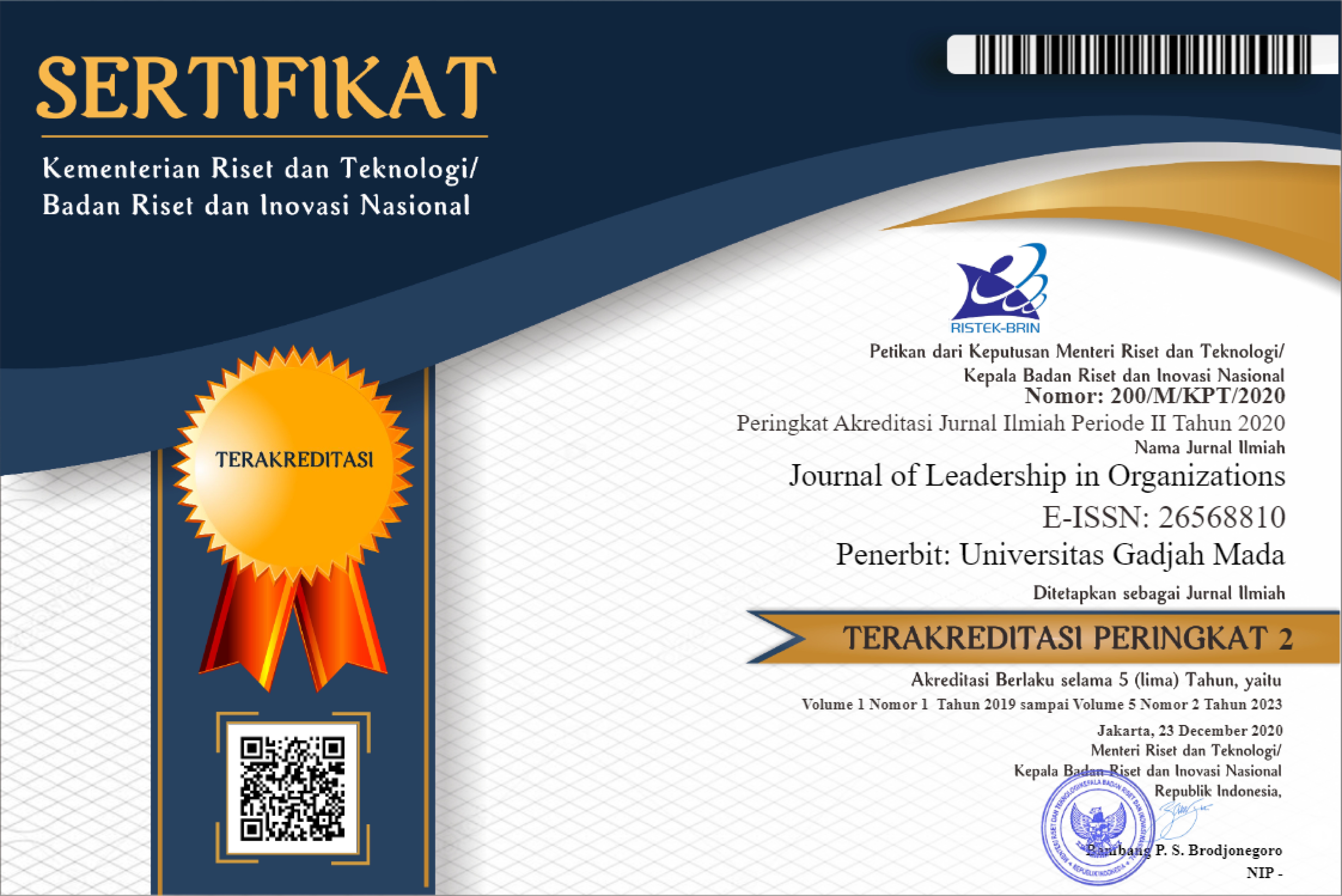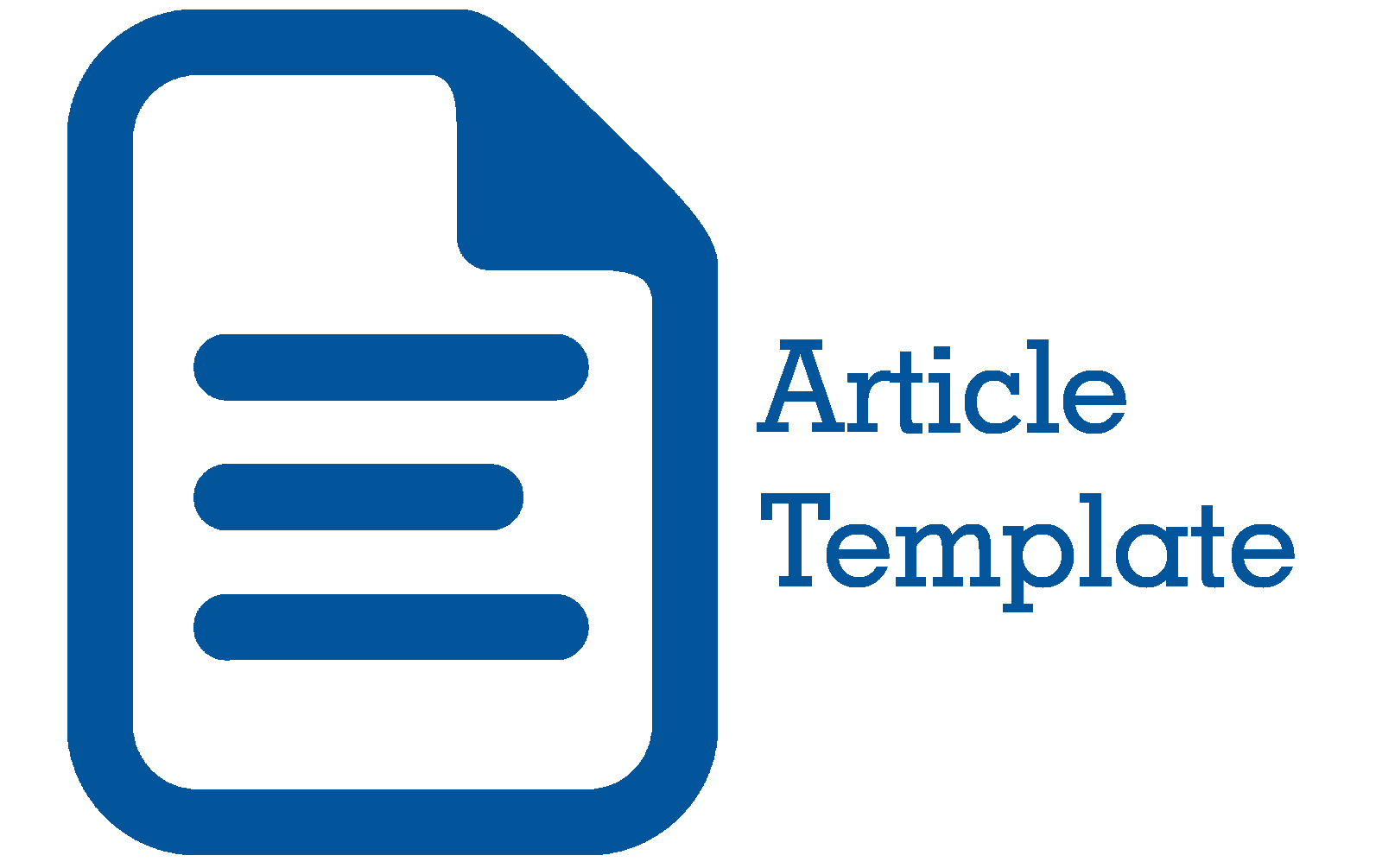Effect of Shared Leadership and Employees’ Creativity: Meaning at Workplace as a Mediation
Muhammad Rasyid Abdillah(1), Rizqa Anita(2*), Edwin Aditya Nugraha(3), Giri Suseno(4), Nor Balkish Zakaria(5)
(1) Department of Management, Graduate School, Universitas Lancang Kuning, Pekanbaru, 28266,Indonesia
(2) Department ofAccounting, Faculty of Economics and Business, Universitas Lancang Kuning, Pekanbaru,28266, Indonesia
(3) Department of Management, Graduate School, Universitas Lancang Kuning, Pekanbaru, 28266,Indonesia
(4) Department of Management, Graduate School, Universitas Lancang Kuning, Pekanbaru, 28266,Indonesia
(5) Accounting Research Institute, Universiti MARA, Shah Alam, Selangor, 40450, Malaysia
(*) Corresponding Author
Abstract
Keywords
Full Text:
PDFReferences
Abdillah, M. R., Anita, R., & Anugerah, R. (2016). The impact of the organizational climate on work stress and employee performance. Journal of Management, 20(1), 121-141.
Abdillah, M. R. (2021). Altruistic Leadership: A Review of the Literature and Agenda for Further Research. Journal of Applied Management and Business, 3(2), 76-85.
Pickles, O. A., Tarakci, M., & Van Knippenberg, D. (2019). Creativity and innovation under limitations: A cross-disciplinary integrative review. Journal of Management, 45(1), 96-121.
Ali, A., Wang, H., & Johnson, R. E. (2020). Empirical analysis of the promotion of co-leadership and team creativity: Adaptive leadership perspectives. Journal of organizational behavior, 41(5), 405-423.
Amabile, T. M., & Pratt, M. G. (2016). Models of dynamic components of creativity and innovation in organizations: Making progress, making meaning. Research in organizational behavior, 36, 157-183.
Anderson, N., Potočnik, K., & Zhou, J. (2014). Innovation and creativity in organizations: State-of-the-science reviews, prospective commentary, and guiding frameworks. Journal of management, 40(5), 1297-1333.
Anita, R., Abdillah, M. R., & Zakaria, N. B. (2021). Authentic leaders and internal whistleblowers: testing dual mediation mechanisms. International Journal of Ethics and Systems, 37(1), 35-52
Baer, M., & Oldham, G. R. (2006). The curved relationship between experienced creative time pressure and creativity: moderating the effect of openness to experience and support for creativity. Journal of Applied Psychology, 91(4), 963-970.
Carson, J.B., Tesluk, P. E., & Marrone, J. A. (2007). Shared leadership in the team: Investigation of antecedent conditions and performance. Journal of the Academy of Management, 50(5), 1217-1234.
Chiu, C. Y. C., Owens, B. P., & Tesluk, P. E. (2016). Starting and leveraging shared leadership within a team: the role of leader humility, the proactive personality of the team, and the team's performance capabilities. Journal of Applied Psychology, 101(12), 1705-1720.
D'Innocenzo, L., Mathieu, J. E., & Kukenberger, M. R. (2016). A meta-analysis of various forms of leadership-performance relationships of shared teams. Journal of Management, 42(7), 1964-1991.
Greer, L. L., Van Bunderen, L., & Yu, S. (2017). Dysfunction of power in the team: A review and perspective of emerging conflicts. Research in Organizational Behavior, 37, 103-124.
Hirst, G., Van Knippenberg, D., Chen, C. H., & Sacramento, C. A. (2011). How does bureaucracy affect individual creativity? Cross-level investigation of the team's contextual influence on goal-relationship orientation of creativity. Academy of management journals, 54(3), 624-641.
Hirst, G., Van Knippenberg, D., Zhou, Q., Zhu, C. J., & Tsai, P. C. F. (2018). The influence of climate exploitation and exploration on performance and creativity: Reduced returns as a function of self-efficacy. Journal of Management, 44(3), 870-891.
Hoch, J. E. (2013). Leadership and shared innovation: Vertical leadership roles and employee integrity. Journal of Business and Psychology, 28(2), 159-174.
Kearney, E., Shemla, M., van Knippenberg, D., & Scholz, F. A. (2019). A paradoxical perspective on the interactive effects of visionary and empowering leadership. Organizational Behavior and Human Decision Processes, 155, 20-30.
Klein, K. J., & Kozlowski, S. W. J. (2000). Multilevel theories, research and methods in organizations. San Francisco: Jossey-Bass.
Liang, B., van Knippenberg, D., & Gu, Q. (2021). A cross-level model of individual leadership, meaning, and creativity. Journal of Organizational Behavior, 42(1), 68-83.
Liu, S., Hu, J., Li, Y., Wang, Z., & Lin, X. (2014). Examining the cross-level relationship between shared leadership and in-team learning: Evidence from China. Leadership quarterly, 25(2), 282-295.
Mainemelis, C., Kark, R., & Epitropaki, O. (2015). Creative leadership: Multi-context conceptualization. Annals Academy of Management, 9(1), 393-482.
Nicolaides, V. C., LaPort, K. A., Chen, T. R., Tomassetti, A. J., Weis, E. J., Zaccaro, S. J., & Cortina, J. M. (2014). Team co-leadership: Meta-analysis of proximal, distal, and moderating relationships. Leadership quarterly, 25(5), 923-942.
Nijstad, B. A., De Dreu, C. K., Rietzschel, E. F., & Baas, M. (2010). Double track towards the model of creativity: Creative ideas as a function of flexibility and perseverance. European Review of Social Psychology, 21(1), 34-77.
Pearce, C. L. & Conger, J.A. (2003). Opportunity landscape: future research on shared leadership. In C.L. Pearce & J.A. Conger (Eds) Shared Leadership: Reframing the Hows and Whys of Leadership (pp. 285–303). Sage.
Pearce, C. L., & Sims Jr, H. P. (2002). Vertical versus shared leadership as a predictor of the effectiveness of change management teams: Examination of unpleasant, directive, transactional, transformational, and empowering leader behavior. Group dynamics: Theory, research, and practice, 6(2), 172-197.
Richter, A. W., Hirst, G., Van Knippenberg, D., & Baer, M. (2012). Creative self-efficacy and individual creativity in a team context: cross-level interaction with team information resources. Journal of applied psychology, 97(6), 1282-1290.
Ros, M., Schwartz, S. H., & Surkiss, S. (1999). Basic individual values, work values, and the meaning of work. Applied psychology, 48(1), 49-71.
Selznick, P. (1957). Leadership in administration. Berkeley, CA: University of California Press.
Shane, W. M., & Field, D. (2007). Explore the impact of shared leadership on the work outcomes of management team members. Journal of Baltic Management, 2(3), 251–272.
Shin, S. J., Kim, T. Y., Lee, J. Y., & Bian, L. (2012). Cognitive team diversity and creativity of individual team members: Cross-level interactions. Academy of management journals, 55(1), 197-212.
Simonton, D. K., Paul, P., & Nijstad, B. (2003). Culture, nation, and creative civilization. In P. B. Paul & B. A. Nijstad (Eds.), Group creativity: Innovation through collaboration (pp. 304-325). New York: Oxford University Press.
Spreitzer, G. M. (1995). Psychological empowerment at work: Dimensions, measurement, and validation. Journal of the Academy of Management, 38(5), 1442-1465.
Thomas, K. W., & Velthouse, B. A. (1990). Cognitive elements of empowerment: An "interpretive" model of the motivation of intrinsic tasks. Academy of management review, 15(4), 666-681.
Zhou, J., & George, J. M. (2001). When work dissatisfaction leads to creativity: Encourages voice expression. Journal of the Academy of Management, 44(4), 682-696.
Zhou, J., & Hoever, I. J. (2014). Research on creativity in the workplace: Review and redirect. Annu. Rev. Organ. Psychol. Organ. Behav., 1(1), 333-359.
Zhou, J., & Shalley, C. E. (2008). Expanding the scope and impact of organizational creativity research. Handbook of organizational creativity, 28(1), 125-147.
Zhou, J., Wang, X. M., Bavato, D., Tasselli, S., & Wu, J. (2019). Understanding the receiving side of creativity: A multidisciplinary review and implications for management research. Journal of Management, 45(6), 2570-2595.
van Knippenberg, D. (2017). Leadership and creativity in business. In M. D. Mumford & S. Hemlin (Eds.), Handbook of research on leadership and creativity (pp. 384-400). Cheltenham, England: Edward Elgar Publishing.
Van Knippenberg, D., & Hirst, G. (2020). The lens model of the motivation of the interaction of people× the situation in the creativity of employees. Journal of Applied Psychology, 105(10), 1129-1144.
Wang, D., Waldman, D. A., & Zhang, Z. (2014). Meta-analysis of shared leadership and team effectiveness. Journal of applied psychology, 99(2), 181-198.Article Metrics
Refbacks
- There are currently no refbacks.
Copyright (c) 2023 Journal of Leadership in Organizations

This work is licensed under a Creative Commons Attribution-ShareAlike 4.0 International License.
| Journal of Leadership in Organizations |
| Journal of Leadership in Organizations (JLO), with registered number ISSN 2656-8829 (Print) and ISSN 2656-8810 (Online), is published by the Center for Leadership Studies, Department of Management, Faculty of Economics and Business, Universitas Gadjah Mada. The content of this website is licensed under a Creative Commons Attribution-ShareAlike 4.0 International License |
| © 2019 Journal of Leadership in Organizations | |





_logo2.png)


.png)




